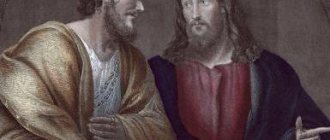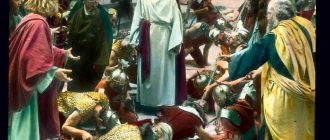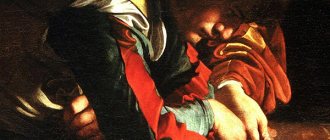The main book for any Christian to read is the Bible. Its main parts are the Old and New Testaments, which tell about God. And if the Old Testament speaks of the path of the Jewish people as God’s chosen ones, then the New Testament calls each and everyone to follow Christ. Most often, it is recommended to start reading the Holy Scriptures with the New Testament, although it is not at the very beginning of the Bible.
In order to correctly understand the deep meanings of sacred lines, one’s own understanding is often not enough. A person, due to his spiritual misunderstanding, can significantly distort what was said many centuries ago. That is why our Church has always advised reading the Holy Scriptures not on their own, but with authoritative interpretations.
The Holy Scriptures contain all the truths of the Christian Church.
The New Testament also consists of several books, the main ones being the four Gospels - Matthew, Mark, Luke and John. It is these Gospels that are considered canonical and reliably convey the events of the earthly life of Jesus Christ. In addition to them, there are so-called apocrypha - descriptions whose authorship has not been reliably established or contain dubious meanings. The apocrypha is not always false or distorted, but in order not to harm your own soul, it is better to read the canonical Gospels. And the first of them belongs to the Apostle Matthew. Let's look at it in more detail.
What is the Gospel of Matthew about?
The main thing that the Evangelist Matthew tells us about is the life and work of Jesus Christ from the beginning of his preaching until the Resurrection. The text was originally intended for Jews, therefore it contains many references to the Old Testament and ancient prophecies. Matthew's purpose was to show that with the coming of the Messiah the prophecies that were written down by the ancient fathers are fulfilled.
The first thing Matthew begins his story with is the genealogy of Jesus Christ, which begins with Adam and ends with Joseph, the Betrothed of the Most Holy Theotokos. Such detail is needed in order to show that Christ came to earth for every person - both those who lived before and those born after.
accomplished by the Savior, and a constant listener of His instructions. Information about his future life can be found in several ancient Christian writers. Thus, Clement of Alexandria and Eusebius testify that in the period after the ascension of Jesus Christ and before the destruction of Jerusalem, Matthew preached the Gospel to the Jews in Palestine. He then left Palestine and spread Christianity to other countries. Information about the extra-Palestinian activities of the Apostle Matthew is extremely scarce. According to this information, he preached the Gospel in Ethiopia, Macedonia, Persia and other Asian countries and died a martyr's death in Hierapolis, Phrygia or Persia.
It has been historically proven that the first Gospel was written by Matthew in the year 42 after the birth of Christ. According to the testimony of Papias, a disciple of the Apostle John, Matthew wrote down the teachings and life of Jesus Christ in Hebrew, or more precisely, Aramaic. Irenaeus, Origen, Eusebius, Jerome and others testify to the Jewish original of the Gospel of Matthew. All of these ancient writers themselves used the Gospel of Matthew in Greek. Many theologians believe that the Apostle Matthew some time later translated his Aramaic Gospel into Greek with some additions for the pagans.
From the Gospel itself we can conclude that its author was a Palestinian Jew: he is well acquainted with the Old Testament, the geography of Palestine, the history and customs of his people. Matthew as the author of the first Gospel is also indicated by the fact that in the list of the apostles of this Gospel there is Matthew. 10:3 his name is marked with the word “publican”; this indicates the deep humility of the author, for publicans were despised by the Jews because of their far from honorable work - collecting taxes or taxes.
It is believed that Matthew wrote his Gospel for the Jews, Mark for the Romans, Luke for the Greeks, and John for the Church; at the same time, all four Gospels are intended to be a message of salvation in Christ. The Gospels of Matthew, Mark and Luke are usually called the Synoptic Gospels. “Synoptic” comes from two Greek words that mean “to see together.” Consequently, the above-mentioned Gospels received this name because they describe the same events in the life of Jesus Christ. Matthew begins the story with Abraham, Mark with Malachi, Luke with John the Baptist, and John with God Himself.
The Gospel of Matthew contains: nine beatitudes, eight “woe to you,” seven successive miracles, five long sermons, four prophecies about the death of Christ. The seventh chapter of Matthew is a continuation of the Sermon on the Mount of the Lord Jesus Christ. This is green pasture, these are four rivers of living water. Preacher D. Moody loved this chapter and left some notes for us. In this chapter we have: two gates - wide and narrow; two roads - narrow and spacious; two classes of people - the many and the few; two destinies - life and death; two trees - good and bad; two fruits - good and bad; two bases - stone and sand; two builders - wise and foolish; two houses; two storms.
The goal of the Evangelist Matthew was to present the history of salvation in such a way as to show that Jesus of Nazareth is the Christ, the promised Messiah, the King of the Jews, whom his own people rejected, but the pagans accepted. Matthew's Jesus Christ is the rejected and coming King and the Messiah predicted by the prophets.
The most important events about the life of Jesus Christ were foreshadowed, therefore it is often repeated in this Gospel: “This happened, that what was spoken by the Lord through the prophet might be fulfilled...” - Matt. 1.22; 2.15. The Gospel of Matthew contains references to 65 passages from the Old Testament, and 45 sayings are given verbatim, that is, as many as there are quotations in the other three Gospels combined. The author shows that in Jesus of Nazareth the whole meaning of the Pentateuch, the prophets and the psalms.
Matthew's method of presentation is special. His work as a tax collector in the past taught him to be neat and orderly. In presenting the story of redemption, the author does not always follow a chronological sequence, but groups together similar events and sermons to enhance their significance. So, for example, in one of the chapters he placed seven of the fourteen parables mentioned in the Gospel, and in another chapter he combined ten miracles out of the twenty given. The teachings of Christ are combined into five sermons: the Sermon on the Mount - chapters 5-7, the Lord's teaching to the apostles - chapter 10, parables about the Kingdom of Heaven - chapter 13, the denunciation of the Pharisees - chapter 23, prophetic predictions about His second coming — 24-25th chapters.
Evangelist Luke, who follows chronological order, can be compared to a botanist who, walking through a meadow, gradually collects all the flowers he comes across. Matthew prefers to select flowers according to their beauty and type, then arranging beautiful bouquets from them.
The main idea in the Gospel of Matthew: The Messiah is the Savior of the world. Matthew does not speak about the ascension of Jesus Christ to heaven, he seems to leave Him on earth. And he ends his story with the words of Jesus Christ: “Behold, I am with you always, even to the end of the age” - Matt. 28.20.
Let us study the Gospel of Matthew, and in it we will certainly find our personal Savior!
How is this Gospel different from others?
The original version of the text was written in Aramaic, unlike the rest of the books, which were in Greek. However, the original was very quickly lost, and the Greek translated version entered the canon.
In this text, the activities of Christ during His earthly life are considered in the following contexts:
- Prophet;
- High Priest;
- Legislator.
As in other parts of the Bible, Matthew focuses specifically on the features of the new teachings of Jesus Christ for the Jews. Despite the great similarity with the remaining synoptic Gospels, it is in the text from Matthew that we can see unique stories:
- healing of blindness of two people;
- liberation from the possession of a mute demoniac;
- a story about a fish with a coin inside.
The parable of the sower is recorded in chapter 13 of the Gospel of Matthew.
Since in all the Gospels many meanings are conveyed through the language of parables, the holy Apostle Matthew also gives similar stories, namely:
- a parable about a feast at a wedding festival;
- a parable about the use of talents;
- the parable of the vineyard and many others.
1 I am what Jesus is
Logia 1
And he said:
To whom the meaning of these words will be revealed,
death will not touch you.
Here we are talking about the inner Jesus, not his many images.
Essentially, we end up saying, “I am Jesus.”
“I am that which Jesus is.” This is different. Jesus said, “I am that which the Father is, but I am not the Father.” It always points to the essence of what is, without naming it in any way. Therefore I will say, “I am That which Jesus is,” but not “I am Jesus.”
Isn't this the same as "I am That"?
When God came down from heaven and Moses asked him, “Who are you?”, he answered, “I am that I am.” Thus he has definitely made it clear that he is the essence of this 'I am'. What consciousness is, but not consciousness itself.
Which could mean that the individual remains...
No, no, on the contrary. In fact, it destroys it. This destroys the definition. Once again: Jesus is a name, a definition. Whereas you are empty. You are the void in which the nature of Christ is found. The Christian tradition says that the essence is the nature of Christ. Just as in Buddhism the essence is the Buddha nature, the true Self. This is just another name for the true Self.
This means that it is important to clarify the meaning of some words.
Yes, and that's why I say, “I am That which is,” not “I am Jesus,” or “I am God,” I don't call it that. There is a book by Nisargadatta called “I am That,” and it leaves That absolutely open. This is destroying the world. This refers exclusively to that which precedes the phenomenal world, and always refers to the noumenon. To something that can neither be named nor described.
There are no different true selves. Even if That seems hidden, in reality it cannot be hidden. There is no hiding place, no veil. Even if That seems to be forgotten for some time, hidden by religion, tradition, still That always lies at the core, That is always present and That will manifest itself again. In all traditions there are mystics and metaphysicians who stand at the top of the pyramid and look down on religions from there. The paths are innumerable, but they all lead to what you are. Because they are all created by the true Self for the sake of the true Self. Therefore, you cannot miss your true Self. Which is the best path? Can not say. When you are at the top, there are no paths at all. But this is not a competition. Every step leads to what you are. There is no way that is better than the other. The True Self knows the best, and there is nothing but the True Self.
When religions go through periods of enormous deviations, reaching such extremes that they seem to have lost all meaning, is this also the way?
Sometimes deviation is the direct path. And sometimes what seems like a straight path turns out to be an endless path. Who decides this? Who sets the standards? What seems so long is nothing to the One who you are. What you are is beyond time, and what is conditioned by time will never become what precedes time.
The message of Jesus is an internal message, he tells us that the true Self is within us, in the secret cave, and this is true. Yet two thousand years ago we latched onto Jesus to make a religion out of him. Paul of Tarski, called the Holy Apostle Paul, invented an absurd religion that claims something completely opposite to what his teacher's message says, promising the individual eternal life in the next world. But this is Disney World!
Yes, absolutely.
And for two thousand years millions of human beings have been at a dead end!
However, if you say that, it means that you still see someone who can reach a dead end. But for That which you are, this is not important, “achieving That which you are” has no meaning. Consequently, everything that this force did was exactly the action that Consciousness, or God, wanted from it. No one can be led astray. And as long as you are someone who can be led astray...
Are you saying that everything that comes from the true Self does not exist?
This is a reflection. But this is not the true Self. And in this reflection they are endless reflections - the right paths and the paths leading to error. Any idea of possible deception requires someone to deceive. And the first thought of “I” is itself a lie. Whether you say, “This leads me,” or, “This leads me astray,” both are lies. As soon as the “I” thought arises, a concept immediately arises, and everything that comes with it leads to delusion. There will never be someone who can come to the right path. The very idea of the right path creates the idea of the wrong path.
This means there is neither good nor evil. Everything is fine. Then the Apostle Paul had a role to play in the design of the true Self.
In Tibetan Buddhism, those who keep a religion or teaching alive are called dharma guardians. For this we need techniques, ways and everything that can be done for this world to exist. This is just an activity that preserves this world. There's nothing true or false about it, that's not the point. For whom should it be true or false?
If you name something something, you give it life. When you say illusion, illusion arises. And whatever you do with it next, you will endow it with reality. The mere fact of saying the word illusion makes it real. This requires someone to say that something is an illusion, but that someone is an illusion itself. The one who gives definitions is himself a definition, a designation. And then, whatever comes from this first definition, whatever a person says, it has no meaning for That which you are. Naming cannot make you what you are. The understanding that the world is an illusion comes and goes, but not You, and You do not depend on this understanding or the realization that it is all a dream. Whatever name you give it will be just another concept.
I completely agree with what you just said. To imagine that any path is possible is to be in complete illusion. Thus, everything that is separate, starting with the personality, is illusory, devoid of existence. And yet there seems to be a self in this improved body of Pithecanthropus.
Yes, but Jesus said: As a man, I am an absolute man. As Spirit, I am absolute Spirit. And as the source, I am the absolute source. Because I am the Absolute under any circumstances. There's no difference.




